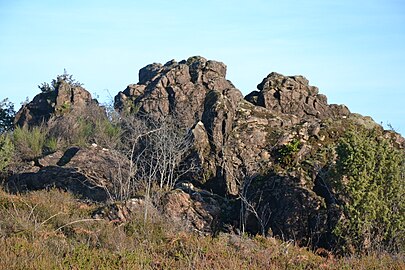Landes de la Flotte et du Cluzeau
The Landes de la Flotte et du Cluzeau are two neighboring heathland areas in the south of the French department of Haute-Vienne . Because of their geological, floristic and faunistic characteristics, they are under nature protection .
geography
The Landes de la Flotte et du Cluzeau, German heathland areas of La Flotte and Le Cluzeau , are named after La Flotte and Le Cluzeau - two hamlets in the area of the municipalities of Château-Chervix and Meuzac . Topographically, they belong to the Monts de Fayat in southern Limousin . The two heathland areas extend over 133 hectares and occupy an altitude of 370 to a maximum of 476 meters above sea level in the middle of the Plateau du Limousin . The two heaths are divided in two by the road from Magnac-Bourg to Le Cluzeau .
geology
The two heathland areas are underlain by quite rare serpentinite , which forms part of the Limousin ophiolite - remnants of the meanwhile almost disappeared ocean of the Massif Central . The ultramafic rock is shed at the base of the upper gneiss blanket . It usually shows a foliation dipping in at 40 ° in an easterly direction , but it can also be very massive. Its outcrop extends from La Porcherie as a discontinuous band further west to the area around Vayres . The occurrence in Vayres - described Merlis-serpentinite - but are of different tectonic significance since they in the footwall of the gneiss ceiling Lower occur.
The serpentinite weathers to soils that are very poor in calcium and aluminum , but have very high concentrations of heavy trace elements such as chromium , cobalt and nickel .
ecology
The heathland essentially consists of open grasslands, which can be divided into the following five ecotopes :
- Atlantic dry heather characterized by the taxa Erica and Ulex
- North Atlantic wet heaths with Erica tetralix
- dense fescue permanent lawn (marked by Festuca lemanii ) and Central European steppes
- Semi- arid lawn with Brachypodium pinnatum and Molinia caerulea (pipe grass litter meadows ) on deeper soils
- pending rock with rock walls
The dry heaths and fescue lawns - two very different ecotopes - replace each other like a mosaic.
flora
For the rest of the region, the two heathland areas are home to plant species that are quite rare and adapted to xerophilic site conditions. Examples are the taxon Notholaena marantae , which belongs to the potted fern family and only thrives on serpentinite, and the carnation family Dianthus hyssopifolius . In the heather, however, there are also more classic plant species such as numerous heather herbs (e.g. Cornwall heather Erica vagans ) and fescue . Among other things grow here also Bogbean ( Menyanthes trifoliata ), Common horseshoe vetch ( Hippocrepis comosa ), marsh gentian ( Gentiana pneumonanthe ), mosquito Händelwurz ( Gymnadenia conopsea ) Sundew ( Drosera rotundifolia ), Summer Twistroot ( Spiranthes aestivalis ) and traubige Grass lily ( Anthericum liliago ).
The fescue lawns are characterized by the taxa grass carnations ( Armeria plantaginea ), Koeleria vallesiana and little meadowsweet ( Filipendula vulgaris ). In the rocky areas there are two remarkable fern species: Notholaena marantae and black-stemmed striped fern ( Asplenium adiantum-nigrum ). In the wet heath, the lung gentian and Erica ciliaris develop in places .
As lichen can be Cladonia arbuscula lead.
fauna
The western water vole ( Arvicola sapidus ) and the swamp shrew ( Neomys anomalus milleri ) appear among the mammals . Several remarkable bird species can also be observed - including the hen harrier ( Circus cyaneus ), the Provence warbler ( Sylvia undata ) and the stonechat ( Saxicola rubicola ) , which breed here . The common snipe ( Gallinago gallinago ) is a puller . Insects such as the dragonfly species helmets ( Coenagrion mercuriale ), the tortoise beetle Cassida panzeri or the marsh cricket Pteronemobius heydeni are definitely worth mentioning. Particular butterflies are blue-sky blue ( Lysandra bellargus ), red-banded velvet butterflies ( Arethusana arethusa ) and mirror-spotted thick-headed butterflies ( Heteropterus morpheus ). Notable among the amphibians are the yellow-bellied toad ( Bombina variegata ), which is under national protection and can be found in damp places and in smaller ponds, and the natterjack toad ( Bufo calamita ).
Protective measures
The Landes de la Flotte et du Cluzeau are under nature protection and form a Type 1 ZNIEFF under number 98 (the French abbreviation stands for Zone Naturelle d'Intérêt Écologique, Faunistique et Floristique - nature zone of ecological, faunistic and floristic interest). In addition, part of the heathland has been specially protected as a socially relevant area since January 12, 1993 as part of Natura 2000 .
Photo gallery
See also
- Geology of the Limousin
- Lande de Saint-Laurent
- Merlis serpentinite
- Limousin ophiolite
- Ophiolite
- Serpentinite
Coordinates: 45 ° 35 ′ 30 ″ N , 1 ° 25 ′ 25 ″ E














